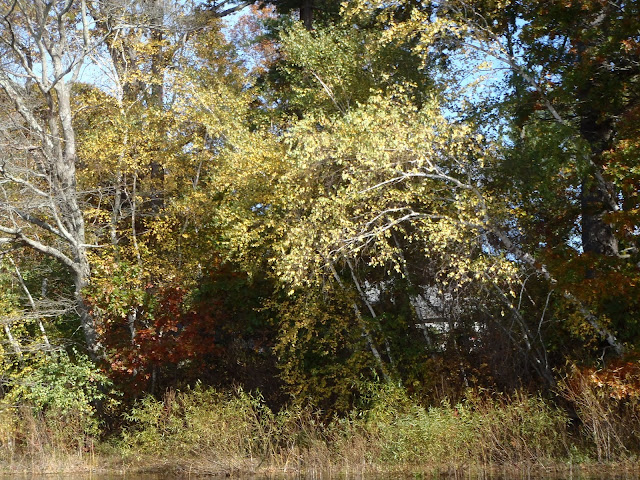Consumed by planning my abortive attempt at the Wampanoag Canoe Passage, I actually only kayaked a few times this season. Today I woke to a bright, cool morning and determined to go to my favorite pond for the first time this year. My only plan was to enjoy whatever fall color remained.
Bridgewater's Nippenicket pond is a mile long with a crinkly shoreline and a few small islands. Waterfront houses both modest and palatial dot the southern shoreline, displaying the variety of ways people enjoy the water. I have habitually wandered these shallows in my kayak and shamelessly gazed into people's backyards. Today, though, I went another way, along the straighter eastern shore and soon reached the northern half, which snugs into the edge of the fabled Hockomock Swamp. I hadn't been this way in over a year, and had forgotten how pretty these wilder parts are.
I would have LOVED to have a treehouse like this overhanging the water. Heck, I'd still love it.
At this point, the road comes close enough to the pond to leave no room for a house lot.
I like to imagine neighborhood kids take advantage of this "unusable" waterfront.
Little fall color remains. Here is, I think, highbush blueberry (above) and black oak (below).
I think this is the last house but one before the Swamp. Quite an estate; a bit out of my price range.
I'm betting nice views from the giant windows and lower and upper decks.
Birch glows in the sun.
A kitchen stool, in good condition, upright, in the middle of nowhere. (This photo
beside entry for "middle of nowhere" in the dictionary.) Evidence for the recent
operation nearby of an Infinite Improbability Drive? Probably not. But still...
Nearing the northern end.
Ponds generally get shallower and smaller over time. This was likely
once an island in the larger pond. Now it is an island in the marsh.
It's hard to see here, but a track through the marsh continuing into a path ashore
tells of regular visitors to this island.
I wish I'd realized where I was when I took the videos below. I was near the northernmost part of the pond--a place usually choked with water plants and nearly impassable, but accessible at the high water level after all the rain we've had. The pond is there the source of a stream that flows into the Swamp, and eventually becomes a major tributary of the Taunton River. In years past I despaired of ever reaching that stream, but it would have been much easier today. I think I see a return trip this season.
Headed home.





















































































